Yucatán and the South
peninsula in Central America
The Yucatán Peninsula is a region of southeastern Mexico, consisting of the Mexican states of Yucatán, Campeche, and Quintana Roo. The adjacent states of Tabasco and Chiapas are also considered part of the Yucatan region on Wikivoyage.
The Yucatán was the home of the Maya civilization before it was conquered by the Spanish Conquistadors in the 16th century. Much of the population is part or all of Maya descent, and in many places the Mayan language is still spoken, usually in addition to Spanish, the main language of business.
Until the mid-20th century, most of the Peninsula's trade with the rest of Mexico was by sea, and the culture, cuisine, and traditions developed different flavors from other parts of Mexico. Starting in the late 20th century the Yucatán has become more integrated into Mexico, especially such areas on the Caribbean coast as Cancún and Chetumal, where many people from other parts of the nation have moved to take advantage of the economic opportunities of development. The Mayan Riviera stretching south from Cancún has seen the most growth related to tourism and the Caribbean coast south of Sian Ka'an is now being referred to as the Costa Maya and is seeing interest from cruise lines as well as beach lovers seeking solitude (which can still be found in southern Quintana Roo, but for how long?).
States
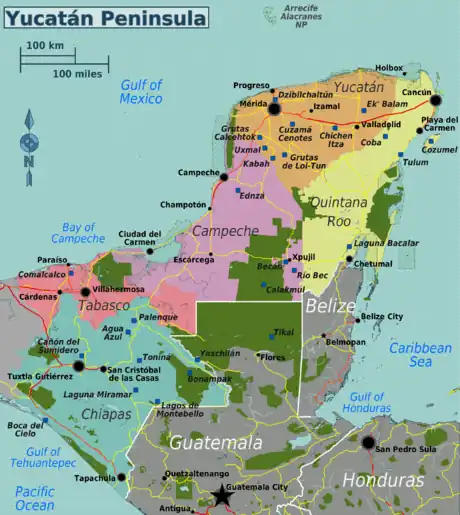
| Quintana Roo Heavy tourist traffic is lured to the northeast of the state, notably by the infamous party city of Cancún, but also by the endless gorgeous Caribbean white sand beaches, some of the world's greatest scuba diving, beautiful cenotes, and a few excellent Mayan sites. |
| Yucatán The Mayan capital of Mexico is home to famous Chichen Itza, but also to more beautiful cenotes, caves, pretty colonial cities, a vibrant capital in Mérida, and is well known as Mexico's safest state. |
| Campeche Decidedly further off the beaten path than busy Yucatán or Quintana Roo, Campeche has its own magnificent Mayan ruins, which you can explore in the quiet of your own company, as well as the touristic beach city of Ciudad del Carmen. |
| Tabasco A state better known for hot sauce than tourism, there are nonetheless a few worthwhile stops here for a cross-country traveler, notably the immodestly named beach town of Paraíso. |
| Chiapas At the southern end of the Peninsula, with the only Pacific coastline in this region, is Chiapas, most notable for the impressive Mayan ruins at Palenque and the colonial town of San Cristobal de las Casas, but also for the beautiful natural, jungle areas in the state's east. |
Cities
- 🌍 Campeche - moderately sized city with Spanish ruins
- 🌍 Cancún - a city built in the 1970s as a resort; it is a modern tourist resort with pristine Caribbean beaches
- 🌍 Chetumal - capital of Quintana Roo, located on the Caribbean coast, close to the Belizean Border with a nice Mayan Cultural museum
- 🌍 Izamal - small mostly Maya city with large colonial convent and remains of large Maya pyramids
- 🌍 Mahahual - small coastal town and cruise ship destination called the Costa Maya
- 🌍 Mérida - colonial city, the metropolis of the Yucatán
- 🌍 Playa del Carmen - was a nice fishermen's town, now has lots of resorts
- 🌍 Progreso - port city with beaches and seafood north of Mérida
- 🌍 Valladolid - small colonial city
Other destinations
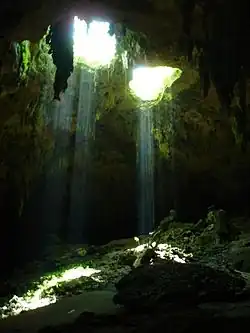
Natural wonders
- 🌍 Cozumel - an island with beaches and ruins, popular base camp for scuba divers
- 🌍 Mayan Riviera - the stretch of coastline between Cancún and Tulum (which includes Playa del Carmen), it is a quickly-developing resort area that still maintains a relaxed atmosphere in contrast to the city of Cancún
- Cenotes of the Yucatán - unique underground cave systems with unique snorkeling and scuba diving opportunities (another system of underground caves is at Lol-Tun)
- Mesoamerican Barrier Reef - huge coral reef system along the Mexican caribbean coast, famous scuba diving and snorkling sites
- 🌍 Sian Ka'an Biosphere Reserve - mangrove swamps, salt marshes, islands, cenotes, beaches, and lots of wildlife
Archaeological sites
Extensive Mayan ruins are found throughout the region, some of which are easily accessible by bus or car. Mayan sites include:
- Becan - large ruin in the lower center of the Peninsula, little restored
- Calakmul - large ruin in jungle preserve, off the tourist trail
- Chichen Itza - the largest, most restored, and most visited of Yucatán's Maya ruins
- Coba - large ruin that has undergone little restoration
- Dzibilchaltún - moderately sized ruin with only a few buildings restored, worth a look on the road between Mérida and Progreso
- Edzna - discovered in the 1950s, the well preserved site an hour's drive from Campeche
- Kabah - medium-sized ruin south of Uxmal
- Mayapan - historically important, and related to Chichen Itza culture
- Palenque - dramatic ruins in the southwest of Mexico's Mayan region
- Tulum - the tropical beach backdrop is the main attraction of this picturesque, much-visited small ruin on the shore of the Caribbean Sea
- Uxmal - one of the most beautiful of all Maya ruins, a large, well-preserved site with fine architecture
Understand
The Yucatán has a rich cultural history. Yucatán is famous for ancient Maya ruins such as Chichén Itzá. Contrary to what some people may think, Mayan culture never "disappeared" and is still very much alive, with most of the Yucatán still predominantly being ethnically Maya. Referring to locals as Mexican rather than Maya, may risk offending them. During colonial rule and after independence, the Yucatan remained culturally distinct from the rest of Mexico because of its isolation. With the first railway and highways only linking it with the rest of the country from the mid-20th century. Before that most trade was by sea with Cuba, Spain and the rest of Mexico.
The region has had a turbulent history. The Maya civilization flourished in the Yucatán Peninsula for more than a thousand years before the Yucatán was conquered by the Spanish in the 1500s. After the Spanish conquest, the region had a colonial caste system with Spanish-born Europeans on top of the social ladder, and pure Mayans coming last. Independence was declared in 1821 before joining Mexico in 1823. Independence was declared for the second time in 1841, with the region remaining independent for seven years, and even flirting with annexation by the United States (the bill even cleared the House of Representatives). In 1847, a caste war broke out between the Mayans and European-descended Criollos. After the war, an independent Mayan state controlled a large part of Quintana Roo, roughly stretching from Tulum to the Belize border. This area was reincorporated into Mexico at the beginning of the 20th century.
The Yucatan has a distinctive ecosystem as a vast limestone peninsula. Ecologically, it's very different from the rest of tropical Mexico, and more similar to Northern Guatemala and Belize, being all on the same peninsula and in geographical Central America. One of the unique features of the landscape are Cenotes. Cenotes are caves or pools of stagnant water that were formed by erosion of limestone. These can range from tiny water wells to huge natural caves. They were one of the few reliable sources of water for the Maya during their heyday. While their exact role is still open to some debate, objects and remains (both animal and human) found in some of them indicate an important religious role. While some Cenotes are closed due to their religious, cultural, or archaeological significance, there are many that you can swim or dive in, with or without guides.
Near Merida is also the place of the Chicxulub meteor impact, that is (according to whom you ask) partly or entirely to blame for the end of the dinosaur age, 65 million years ago. While hardly anything of it can be seen today, the location of some cenotes (see below) is a good indicator for the size of the crater, as they still form a circle segment that, when followed to the ocean, gives you the full size of the impact crater.
Talk
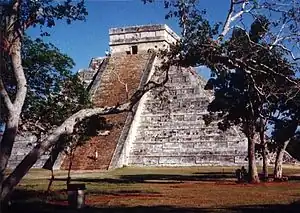
Spanish is the main language. English will be understood in most tourist locations and resorts. Knowing a few phrases of basic Spanish will help away from the main tourist resorts and can often help you find better deals. Yucatecos are generally tolerant of visitors who do not speak Spanish fluently but appreciate the effort to learn Spanish.
In much of the Yucatán some Maya is spoken. Except in a few small villages, almost everyone will have at least a working knowledge of basic Spanish.
Maya place names are usually accented on the last syllable, otherwise generally pronounced the same as in Spanish. The letter "X" in Yucatán is used for the sound in the Maya language that's the same as "Sh" in English. For example, "Uxmal" is pronounced "Oosh-MAL".
Get in
By plane
🌍 Cancún International Airport (CUN); 🌍 Cozumel International Airport (CZM), 🌍 Manuel Crescencio Rejón International Airport (Merida) (MID), and 🌍 Tulum International Airport (TQO) are the most popular entry points to the Yucatan peninsula from all over Mexico. There are direct international flights from Canada, Cuba (handy for unofficial visits to Cuba), Europe, Central America, the United States and South America into Cancun and only from the United States and Canada to Merida and Cozumel. There are also alternative airports with connections from Mexico which may be closer to your final destination in:
- 🌍 Angel Albino Corzo Airport (TGZ) in Tuxtla Gutierrez is the largest airport in Chiapas state closest to San Cristobal de las Casas, Comitan, Chiapas de Corzo and Cañón Sumidero.
- 🌍 Alberto Acuña Ongay International Airport (CPE ) Smaller airport south of Campeche with domestic flights from Mexico City only.
- 🌍 Chetumal International Airport (CTM) Smaller airport in Chetumal with domestic flights from Mexico City and international connections from Belize City with Tropic Air. It is also another transit point for onward travel to Flores, Guatemala (Tikal) and to Belize from Mexico City as it may be less expensive to fly to Chetumal from Mexico City (or elsewhere in Mexico) and continue by bus or shuttle to Belize City then flying into Belize City from Mexico City.
- 🌍 Carlos Rovirosa Pérez International Airport (VSA) in Villahermosa is the largest airport in the state of Tabasco and the nearest commercial airport to Palenque town and ruins which are 2-3 hr east of Villahermosa in the state of Chiapas.
- 🌍 Tapachula Airport (TAP ) Nearest airport to Tapachula, Puerto Chiapas and the Guatemalan frontier towns of Cd Hidalgo/Cd Tecun Uman; and Talisman/El Carmen. It is also another transit point for onward travel to Guatemala from Mexico as it may be less expensive to fly to Tapachula from Mexico City (or elsewhere in Mexico) and continue by bus or shuttle to Guatemala then flying into Guatemala City from Mexico or the U.S.
- 🌍 Benito Juarez International Airport (MEX) Not in the Yucatan Peninsula or Chiapas, but it is the hub for most major airlines in Mexico with connections from China, Japan, USA, Canada, Europe and South America from foreign flag carriers. Some of the smaller airports in the region are connected only from Mexico City. Average flight times from Mexico City to most places in the region are 2 hr.
By car
Driving is the least common way to reach the Yucatan Peninsula. From Mexico City, it is over 1,300 kilometers to Merida and the drive takes 18 hours. Federal highway MEX-180 (MEX-180D toll road) is a good highway going the entire distance.
By bus
The following bus company serves the eastern and southeastern regions of the country in different route combinations and into Belize via Chetumal:
- ADO (Autobuses Del Oriente), ☏ +52 55 5133-5133, toll-free: 01 800-009-9090. They operate the ADO, ADO GL, AU (Autobus Unidos), OCC (Omnibus Cristobal Colon), Platino bus lines and the ClickBus booking site (formerly Boletotal & Ticketbus). They are a major bus company in the states of Chiapas, Tabasco, Yucatan, Quintana Roo and Campeche from Terminal TAPO and Terminal Norte in Mexico City and from multiple cities in the neighboring states of Oaxaca and Veracruz. They also offer regularly scheduled airport buses and shuttles and/or airport taxis on demand in Cancun, Chetumal, Campeche, Merida, Tapachula, Tuxtla Gutierrez and Villahermosa. It is wise to use their app for buying and storing tickets, as you do not have to deal with buying them in person - when buying the ticket online, just show the QR code from the app to the bus driver. (updated Feb 2022)
It is possible to take a bus all the way from Mexico City to the Yucatan, however most often this is not or only marginally cheaper than a flight and you'd be in for 20 hours or more of continuous travel.
The following are first class (pullman) buses from Tapachula to Guatemala. Passengers transfer in Guatemala City to continue to other parts of Guatemala and to Honduras and El Salvador. Addresses and phone numbers given are from Guatemala City:
- Linea Dorada, 16 Calle 10-03 Zona 1, ☏ +502 2415-8900. Goes west to Tapachula, Huehuetenango and/or Quetzaltenango and north to Flores/Santa Elena from Guatemala City (updated Jun 2018)
- Ticabus (Transportes Internacionales Centroamericanos), Calzada Aguilar Batres, 22-55 Zona 12 Guatemala, ☏ +502 2473-3737. International bus company going across the Central American isthmus between Panama City and Tapachula through San José, Managua, San Salvador and Guatemala City.
- Trans Galgos Inter., 7a Avenida 19-44 Zona 1, ☏ +503 2232-3661, +503 2220-6018, +503 2230-5058. departs 13:00. International services to Tapachula from Guatemala City via Retalhuleau and Coatepeque on one route and twice daily to San Salvador on another. They also operate a third domestic route to Quetzaltenango from Guatemala City. They also book onward travel all the way to the U.S. border through Mexico. US$17.
By train
Passengers traveling on the Ferrocarril Interoceanico from Coatzacoalcos. Veracruz or Salina Cruz, Oaxaca can use the FA line to arrive at Palenque, where they can transfer to the Tren Maya for continuing service throughout the Yucatan Peninsula.
Get around
By car
The Yucatan is the easiest part of Mexico to drive around in. Aside from Cancun and Merida, there are few real urban areas. Car rentals are easy to arrange in major airports and resort areas, and the only real worry is making sure that you observe local traffic laws (especially speed limits).
By bus
Many different class buses are available to/from all the major and many of the minor cities. Mexican first class buses are excellent value and remarkably comfortable - comparable to European train services. Many cheaper services are also available - from second class (little noticeable difference really) to very basic minibus and truck services. Safety seems to decrease with price, however - second class and below may lack seatbelts. Major differences between first and second class is that first class use toll highways where available and make limited or no stops en-route. Second class buses operate on shorter routes along 'libre' highways through every hamlet, village, town and city; with stops anywhere along the road to pick up and drop off people. Beware of the excessive air conditioning that seems to be a feature on most services - the bus may be many degrees colder than the outside air, and being stuck on a twelve hour journey without adequate clothing can make a journey singularly unpleasant. Travelling second class is not recommended for taller people. As second class buses hold more seats than first class ones do, there is almost no leg room. The major first class bus line is Autobuses del Oriente (ADO). Most of the smaller lines (Mayab, for example), are owned by ADO.
By combi
Combis are collective-taxis (colectivos) in form of mini vans (Toyota Hiace, Chevy Express, Ford Econoline, Ford Transit, Dodge/Mercedes Sprinter) offer services to many of the small towns & villages from a bigger town or city and between the small towns. Cheaper than a taxi and usually faster than a bus since it makes fewer stops.
By taxi
Available for hire even in small towns. For long distances however, like the caves at Lol-tun, be sure to agree on a price before boarding, or you might get ripped off.
By train
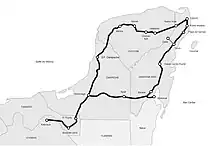

The Mexican government is nearing completion of an enormous high-speed train project called Tren Maya that will operate a 1,525 km loop route through the Yucatan Peninsula, opening up fast, comfortable transportation between Mexico's most popular beach resorts and some of its largest Mayan archaeological sites.
The northern side of the loop runs from Palenque to Cancun. The entire northern leg was open by the end of 2023. The eastern side of the loop runs along the Quintana Roo coast through the Maya Riviera to Chetumal and the Belize border, where it loops westward via the southern leg. The section from Cancun to Playa del Carmen opened at the end of February 2024, Tulum opened in May, and additional stations will open throughout 2024 with all of the eastern and southern stations slated for completion by the end of 2024.
Some of the Mayan sites that will be opened up to visitors include Calakmul and the seldom visited Ruta Rio Bec sites, along with Izamal, Edzna, and Palenque. Increased tour services and bus transportation is planned between Palenque and sites at Yaxchilan and Bonampak. Although some of the sites are already popular among international travelers, the train will also boost attendance at Chichen Itza and Tulum, both of which will have stops on the route. Shuttle service will be available to Coba from the Tulum station.
Major cities on the new train route will include Merida, Chetumal, and Campeche.
Tickets can be purchased at ticket windows in stations or through the Tren Maya website. Ticket prices depend on distance, fare class, and residency. Local residents of the 5 Yucatan Peninsula states pay the lowest fare, Mexican nationals from other states pay a mid-tier fare, Foreign travelers pay the highest fare (roughly double the local price). As of early 2024, foreign visitors can buy tickets in tourist class or premier class. Sample fares are:
- Cancun to Merida - M$735 (Tourist class), M$1173 (Premier class)
- Cancun to Palenque - M$2123 (Tourist class), M$3391 (Premier class)
See
- Mayan archeological sites. Yucatán is home of several famous Mayan archaeological zones. The best known and most widely visited by tourists is Chichén Itzá, the site of the Kukulcan Pyramid, the Maya Observatory, and the Sacred Cenote. A contrasting cultural style, more ornamental, can be observed at Mayan sites along the Ruta Puuc. The most famous Mayan sites in Quintana Roo are located at Coba and Tulum.
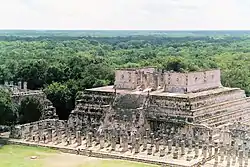 Temple of the Warriors at Chichen Itza
Temple of the Warriors at Chichen Itza - Equinox: The period when the Earths sun is directly above the equator, about Mar 20 & Sep 23 of each year. Mayans were very dependent on astronomy as reflected in their art and Temples. At Chichen Itza, during sunset on the Equinox, the shadows of the serpent-god Kukulcan, moves down along the pyramid, a very impressive sight! Other structures have Equinox related events that take place on those days also, like Tulum.
- Ecological parks: The Yucatán Peninsula is site of several Ecological Parks, like Xcaret, Xel-Há and Garrafón; aimed for the conservation of the flora and fauna of the region, which serve as well as tourist attractions. At these parks you can know more about the Mexican culture, and also enjoy several activities as swimming with dolphins and snorkeling.
Itineraries
- Cenotes of the Yucatán are complexes of sinkholes and caves in the Karst geological landscape of the Yucatán. Some cenotes contain spectacular cave formations, while others are important archeological sites, and several were considered sacred by the Mayans. A few are open to the public for swimming and diving. The states of Yucatán and Quintana Roo have established a "tourist corridor" called La Ruta de los Cenotes along which many of the most spectacular or famous cenotes are situated.
- Ruta Puuc is an itinerary developed by the Mexican tourism department (SECTUR), which has placed signage along the highways in the Puuc region (Yucatan hill country) to guide travelers to the Mayan archaeological sites that best exemplify Mayan Puuc architecture.
- Ruta Rio Bec is an itinerary developed by the Mexican tourism department (SECTUR) that spotlights Mayan archaelogical sites that exemplify Rio Bec architecture. The route formally runs from Chetumal to Escárcega, but the sites cluster near the town of Xpujil
Do
- Reef diving and snorkeling. The Mesoamerican Barrier Reef, the second largest coral reef system in the world, lies offshore in the Caribbean east of the Yucatán. It extends all the way to the Bay Islands of Honduras.
Eat
Yucatecan food has its own culinary traditions developed from the long mix of native Maya and Spanish traditions. While some dishes can be very spicy, many others are not. Genuine Yucatecan salsas are prepared with habañero chiles and can be quite spicy. The ubiquitous El Yucateco brand is served throughout the region (and is exported to other countries). Chiltomate is a salsa prepared with fire-roasted tomatoes.
Common meats are turkey, chicken, pork, and deer. Yucatecan venison is quite good and not "gamey" tasting.
Typical dishes include:
- Pibil dishes, such as "cochinita pibil" (suckling pig) and "pollo pibil" (the chicken version), rubbed with achiote (also known as annato), marinated with sour orange juice, wrapped in a banana leaf, then slow cooked in a pit barbecue. This is one of the region's emblematic dishes and is a recipe and process used by Mayan cooks since ancient times. Very tender and tasty. Typically served as a taco and topped with pickled red onion.
- Poc Chuc is another traditional Mayan dish that is still served throuighout the Yucatan Peninsula. It is lean pork, marinated in sour orange juice and then slow-roasted over charcoal coals. Served with red pickled onions, avocado and salsa or chitomate.
- Sopa de lima, tasty lime-based vegetable soup with bits of corn tortilla. This is another regional specialty that originates with the Mayan community.
- Huevos Motuleños are eggs on tortillas with black beans and cheese, often with other ingredients such as ham, peas, and tomato sauce. The dish originated in the town of Motul but is served everywhere in the Yucatan.
- Pollo Motuleño, a chicken dish cooked with orange juice, achiote and plantains.
- Salbutes - like a tostada, but with a fresh corn tortilla that's freshly fried then topped with cochinta pibil, a relleno (turkey topping available in black (negro) and white (blanco) variations, among other meats or toppings. Topped with salsa, avocado, cheese or anything you might normally put on a taco
- Panuchos - "sopes" with pork (cochinita pibil) or more commonly, black beans
- Marquesitas - popular dessert from street food vendors, a crispy crepe is filled with fruits, cream, cheese, cajeta or other sweet flavors. Chocolate and Nutella are popular flavors.
Seafood is also very important, especially in Campeche. Pulpo (octopus), cazon (shark), camaron (shrimp) and various other tropical fish are very popular. Lobster is a widely available in the Yucatan. It is normally a spiny lobster, which is a smaller variety than the Maine lobsters preferred in the U.S.
Contrary to the advice of many guides, the food served in all-inclusive resorts may have been prepared in far less safe conditions than that available in local establishments away from the major tourist zones. Poor refrigeration, retaining food beyond safe time limits and poor hygiene have been reported from many resorts - whereas street vendors patronized by locals have little choice but to maintain high standards, as everything is on view and their business is dependent on their reputation, not passing foreign visitors. Street vendors cooking for a local clientele are also far more likely to adhere to authentic (often time-intensive) processes and far less likely to substitute cheap mass-market processed ingredients.
A good approach for regular restaurants is to note those with a lot of locals and to patronize them.
Drink
Tap water is not generally advised for drinking in Mexico, particularly for visitors. In many places (particularly backpacker-friendly resorts) water containers can be filled with drinking water for a few pesos - so a reusable container is both an environmentally and financially better option.
The water system in Mérida is unusually good for Mexico; for some visitors it is the only Mexican city where they will drink the tap water. Outside of this city the situation is different. In small towns the local water can be very bad, and bottled water is recommended.
It would be difficult for anyone visiting this area not to sample the Tequila, which should be used in moderation. For those more adventurous souls, Absinthe is legal in Mexico and also, moderation is suggested. Fresh fruit juice is very popular in The Yucatán and freshly squeezed OJ can be found in most markets. Dairy products, including cheese, should be avoided, unless you are positive they have been made with pasteurized milk.
Respect
Away from beaches and tourist hotels going around in a bathing suit or short shorts is considered improper and rude.
Stay safe
Strict drug possession policy exists in Mexico. Be very careful even with "greens". Local police are hopelessly corrupt and love to catch unwary tourists with small quantities of marijuana. Threatening long prison terms, whether this is a likely outcome is a moot point, their main aim seems, unsurprisingly, to exact bribes: in some areas a fairly standard 50% of all the traveller's money.
There have been several cases of young European and U.S. visitors getting shot when they approached local drug dealers to make a purchase. Yucatan is not a dangerous region, but stupid foreigners getting into trouble sometimes make it seem so.
Caution is also advised on long bus journeys, particularly across state lines, as police or military checkpoints exist and passengers may be asked for identification or searched. In general, however, these checks seem to be aimed at locals, particularly in the Zapatista homeland in Chiapas.
Go next
Neighboring states are Quintana Roo to the east and Campeche to the west.
The Yucatán is a good launching point for going to Belize, Cuba and Guatemala.
Wikivoyage: Latitude 18.255000, Longitude -89.925556 (Map, Geohack)
Wikidata: Latitude 19.55111, Longitude -89.29639 (Map, Geohack)
Difference: 158.7km